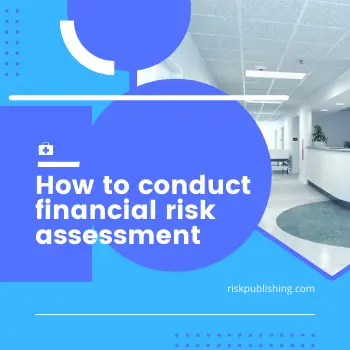A risk assessment is a systematic process of identifying and evaluating potential risks to determine their impact and likelihood.
It involves analyzing various factors such as hazards, vulnerabilities, and consequences to determine the level of risk associated with a particular activity, project, or situation.
As the U.S. Environmental Protection Agency prescribes, risk assessments ensure the safety and well-being of individuals, organizations, and the environment. This government agency ensures engineering controls and administrative controls protect the various organizations.
Identifying potential risks and implementing appropriate control measures can significantly reduce the likelihood of accidents, injuries, or other adverse events.
This article provides examples of risk assessments and highlights their importance in various contexts, such as protective equipment.
Readers can gain knowledge on creating their own risk assessment checklists and submitting them for review by understanding the process and principles behind risk assessments.

What is a Risk Assessment?
A risk assessment is a systematic process used to identify, evaluate, and prioritize potential risks that could impact the achievement of objectives within an organization.
It involves a series of steps to assess potential hazards, potential impacts, and potential adverse effects. Engineering, administrative, and additional controls assist in equipment maintenance procedures.
The risk assessment process begins with the identification of hazards that could pose a threat to the organization’s objectives.
This is followed by evaluating the likelihood and severity of the identified risks.
Control measures and corrective actions are then implemented to mitigate the risks and prevent or minimize their adverse effects.
The risk assessment process is essential in ensuring the safety and well-being of individuals, as it includes human health risk assessments to evaluate the potential risks to human health associated with the identified hazards.
Why is it Important?
Large-scale assessments are important because they comprehensively evaluate the risks and hazards associated with a particular situation or activity. These assessments help to identify potential risks on a larger scale and determine the appropriate measures to mitigate them.
Additionally, required specific assessments ensure that all necessary aspects are considered and evaluated, leaving no room for oversight or neglect.
Lastly, hazard risk assessments play a crucial role in identifying and assessing potential hazards, allowing for the development of effective risk management strategies.
Overall, these assessments are essential for ensuring the safety and well-being of individuals and the environment.
Large Scale Assessments
Conducting comprehensive evaluations on a grand scale allows for examining potential risks across various areas.
Large-scale assessments are an ongoing process that involves using risk assessment templates to identify and analyze various risk levels. These assessments are crucial in identifying compliance risks and developing effective risk management strategies.
Through the examination of risks on a broader scale, organizations can gain a deeper understanding of the potential consequences and impacts of different hazards.
This knowledge enables them to implement appropriate risk analysis measures and effectively develop strategies to mitigate risks.
Large-scale assessments also play a significant role in ecological risk assessments, providing a comprehensive understanding of the potential environmental impacts and allowing for sustainable risk management strategies.
Large-scale assessments facilitate a thorough and logical approach to risk assessment and help organizations make informed decisions regarding risk management.
Required specific assessments
Required specific assessments provide valuable insights into potential risks and their associated impacts, fostering a sense of urgency and responsibility within organizations to prioritize risk management strategies.
These assessments involve evaluating various factors such as risk ratings, potential risks, likelihood of risk, hazard identification, and types of hazard.
Organizations can identify and analyze potential risks that threaten their operations, employees, or assets through a risk assessment.
This process allows for a systematic approach to identify areas of concern and develop appropriate risk mitigation measures.
Through structured assessments, organizations can comprehensively understand their vulnerabilities and prioritize their resources accordingly.
This enables them to proactively address potential hazards and minimize the likelihood of adverse events.

Hazard risk assessment
Hazard risk assessment systematically evaluates potential hazards and their associated impacts, providing organizations with valuable insights to develop effective risk mitigation strategies.
This type of assessment is crucial in identifying and prioritizing potential hazards that may threaten the organization’s operations, employees, and the environment.
It helps organizations understand the likelihood and severity of each hazard, enabling them to implement appropriate control measures to reduce the risk. A hazard risk assessment typically involves the following steps: hazard identification, risk analysis, risk evaluation, and risk control.
Organizations can proactively identify and address potential risks by conducting a hazard risk assessment before they escalate into incidents or accidents. This helps organizations ensure the safety and well-being of their stakeholders while maintaining business continuity.
| Hazard | Potential Impact |
|---|---|
| Fire | Property damage, injury, loss of life |
| Chemical spill | Environmental contamination, health risks |
| Machinery malfunction | Injury, production downtime |
| Cybersecurity breach | Data loss, reputational damage |
Examples of Risk Assessments
Exemplifying the importance of thorough risk assessments, the following examples showcase the potential dangers and vulnerabilities that can arise in various contexts.
– In cybersecurity, a risk assessment example involves identifying potential threats to a network, assessing their likelihood of occurring, and estimating the potential impact on data security. This process helps organizations implement appropriate safeguards and develop incident response plans.
– Another risk assessment example can be seen in the construction industry, where hazards such as falls, electrical shocks, and exposure to hazardous substances are evaluated.
Safety measures can be implemented to protect workers and mitigate potential accidents by quantifying the probability and severity of these risks.
– In the healthcare sector, risk assessments are crucial for patient safety. For instance, a risk assessment may involve identifying potential hazards in a hospital environment, such as medication errors or spreading infectious diseases.
Healthcare providers can implement preventive measures and ensure patient well-being by characterizing these risks and estimating their likelihood.
These examples highlight the diverse tasks of risk assessment, including risk characterization, description, and estimation. By thoroughly analyzing potential risks, organizations can minimize the likelihood of actual risks and their associated consequences.
Create Your Own Risk Assessment Checklist
To effectively evaluate potential risks, organizations can develop a comprehensive checklist that systematically identifies and analyzes various elements contributing to vulnerabilities and hazards in a given context.
Creating a risk assessment checklist allows organizations to assess potential risks in a structured and objective manner. This checklist can include factors such as:
– The identification of potential hazards.
– Evaluation of the likelihood and severity of risks.
– Assessment of control measures in place.
– Consideration of regulatory requirements.
Organizations can also incorporate additional guidance from regulatory agencies, such as risk assessment templates or industry-specific guidelines.
A risk matrix can categorize risks based on their likelihood and severity, helping organizations prioritize their efforts.
Furthermore, developing a control plan can outline the measures and actions necessary to mitigate identified risks.
Overall, risk assessment helps organizations proactively identify and manage potential vulnerabilities, ensuring the safety and security of their operations.
Submitting the Risk Assessment
After creating your own risk assessment checklist, the next step is to submit the risk assessment.
This involves conducting an exposure assessment to determine the level of risk associated with each hazard identified in the checklist. The exposure assessment evaluates the likelihood and severity of potential workplace hazards and operational risks.
Once the level of risk is determined, it is important to develop a control program to mitigate these risks. This program should include implementation specifications and guidelines for addressing each hazard identified.
Additionally, incident investigation techniques should be incorporated into the control program to identify and analyze any possible incidents.
Submitting the risk assessment and implementing the control program allows organizations to manage and mitigate the risks associated with workplace hazards effectively.
Frequently Asked Questions
What are the different types of risks that can be assessed in a risk assessment?
Types of risks that can be assessed in a risk assessment include financial, operational, strategic, compliance, and reputational risks. These risks are evaluated to identify potential threats and their impact on an organization’s objectives.
Are there any legal requirements for conducting a risk assessment?
Yes, there are legal requirements for conducting a risk assessment. In many countries, employers are legally obligated to assess and manage risks in the workplace to ensure the health and safety of employees and others.
How often should a risk assessment be reviewed or updated?
Risk assessments should be reviewed and updated regularly to remain accurate and effective. The frequency of review will depend on the risks involved. Still, a general guideline is to review them at least annually or whenever significant changes in the workplace or work processes occur.
What are some common methods or tools used for conducting a risk assessment?
Common methods or tools used for conducting a risk assessment include checklists, interviews, brainstorming sessions, and SWOT analysis. These approaches help identify, evaluate, and prioritize potential risks systematically and comprehensively.
Are there any limitations or challenges associated with conducting a risk assessment?
Conducting a risk assessment may face limitations and challenges. These can include subjective judgments, lack of data or expertise, difficulty quantifying risks, and potential biases or errors in the assessment process.

Conclusion
Risk assessments are crucial in identifying potential risks and hazards in various contexts, such as workplaces, industries, and daily activities. Organizations can proactively prevent accidents or damages by systematically evaluating and analyzing potential risks.
This article has discussed the significance of risk assessments, providing examples for a better understanding. Additionally, it has guided readers on creating their own risk assessment checklists.
Overall, risk assessments are essential tools for mitigating risks and ensuring the safety of individuals and organizations.
| Hazard | Potential Impact |
|---|---|
| Fire | Property damage, injury, loss of life |
| Chemical spill | Environmental contamination, health risks |
| Machinery malfunction | Injury, production downtime |
| Cybersecurity breach | Data loss, reputational damage |
Examples of Risk Assessments
Exemplifying the importance of thorough risk assessments, the following examples showcase the potential dangers and vulnerabilities that can arise in various contexts.
- In the field of cybersecurity, a risk assessment example involves identifying potential threats to a network, assessing their likelihood of occurring, and estimating the potential impact on data security. This process helps organizations implement appropriate safeguards and develop incident response plans.
- Another risk assessment example can be seen in the construction industry, where hazards such as falls, electrical shocks, and exposure to hazardous substances are evaluated. By quantifying the probability and severity of these risks, safety measures can be implemented to protect workers and mitigate potential accidents.
- In the healthcare sector, risk assessments are crucial for patient safety. For instance, a risk assessment may involve identifying potential hazards in a hospital environment, such as medication errors or the spread of infectious diseases. By characterizing these risks and estimating their likelihood, healthcare providers can implement preventive measures and ensure patient well-being.
These examples highlight the diverse tasks of risk assessment, including risk characterization, description, and estimation. By thoroughly analyzing potential risks, organizations can minimize the likelihood of actual risks and their associated consequences.
Create Your Own Risk Assessment Checklist
To effectively evaluate potential risks, organizations can develop a comprehensive checklist that systematically identifies and analyzes various elements that may contribute to vulnerabilities and hazards in a given context.
Creating a risk assessment checklist allows organizations to assess potential risks in a structured and objective manner. This checklist can include factors such as:
- The identification of potential hazards
- Evaluation of the likelihood and severity of risks
- Assessment of control measures in place
- Consideration of regulatory requirements
Organizations can also incorporate additional guidance provided by regulatory agencies, such as risk assessment templates or industry-specific guidelines.
A risk matrix can be used to categorize risks based on their likelihood and severity, helping organizations prioritize their efforts.
Furthermore, the development of a control plan can outline the measures and actions necessary to mitigate identified risks.
Overall, the assessment of risk helps organizations proactively identify and manage potential vulnerabilities, ensuring the safety and security of their operations.
Submitting the Risk Assessment
After creating your own risk assessment checklist, the next step is to submit the risk assessment.
This involves conducting an exposure assessment to determine the level of risk associated with each hazard identified in the checklist. The exposure assessment evaluates the likelihood and severity of potential workplace hazards and operational risks.
Once the level of risk is determined, it is important to develop a control program to mitigate these risks. This program should include implementation specifications and guidelines for addressing each hazard identified.
Additionally, incident investigation techniques should be incorporated into the control program to identify and analyze any incidents that may occur.
By submitting the risk assessment and implementing the control program, organizations can effectively manage and reduce the risks associated with workplace hazards.
Frequently Asked Questions
What are the different types of risks that can be assessed in a risk assessment?
Types of risks that can be assessed in a risk assessment include financial, operational, strategic, compliance, and reputational risks. These risks are evaluated to identify potential threats and their potential impact on an organization’s objectives.
Are there any legal requirements for conducting a risk assessment?
Yes, there are legal requirements for conducting a risk assessment. In many countries, employers are legally obligated to assess and manage risks in the workplace to ensure the health and safety of employees and others.
How often should a risk assessment be reviewed or updated?
Risk assessments should be reviewed and updated regularly to ensure that they remain accurate and effective. The frequency of review will depend on the specific risks involved, but a general guideline is to review them at least annually or whenever there are significant changes in the workplace or work processes.
What are some common methods or tools used for conducting a risk assessment?
Common methods or tools used for conducting a risk assessment include checklists, interviews, brainstorming sessions, and SWOT analysis. These approaches help identify, evaluate, and prioritize potential risks in a systematic and comprehensive manner.
Are there any limitations or challenges associated with conducting a risk assessment?
Conducting a risk assessment may face limitations and challenges. These can include subjective judgments, lack of data or expertise, difficulty in quantifying risks, and the potential for biases or errors in the assessment process.
Conclusion
Risk assessments play a crucial role in identifying potential risks and hazards in various contexts, such as workplaces, industries, and even daily activities. By systematically evaluating and analyzing potential risks, organizations can take proactive measures to prevent accidents or damages.
This article has discussed the significance of risk assessments, providing examples for a better understanding. Additionally, it has guided readers on creating their own risk assessment checklists.
Overall, risk assessments are essential tools for mitigating risks and ensuring the safety of individuals and organizations.

Chris Ekai is a Risk Management expert with over 10 years of experience in the field. He has a Master’s(MSc) degree in Risk Management from University of Portsmouth and is a CPA and Finance professional. He currently works as a Content Manager at Risk Publishing, writing about Enterprise Risk Management, Business Continuity Management and Project Management.

